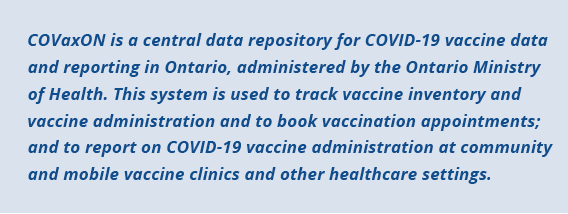Bridging the Digital Divide in Community – Lessons from the pandemic
It is less about technology and more about knowing and working with people.
On December 29, 2020, the UHN Connected Care team was given about 48 hours to start rolling out mobile teams to administer COVID-19 vaccines in long-term care homes and at-risk communities across the GTA. The stakes were high – people were tired of COVID-19 restrictions, and there was an urgent need to provide a ring of protection around the most vulnerable populations.
Finding personnel, appropriate and accessible venues for the clinics in such short notice came with challenges, which we addressed through collaboration and partnership with community. We had lots of volunteers – from administrative staff to clinicians who qualified under the medical directive to administer the vaccine.
From the start, we understood our role as guests in the long-term care homes and in the community. Trust and respect were crucial, as was making local teams feel ready and comfortable to participate.
The Ontario Ministry of Health (MOH) created the legal and policy framework to get the job done, for example the medical orders and the necessary mandates to expedite vaccination efforts in each clinic. The MOH created billing codes, thereby eliminating another often-overlooked barrier.
In the early phases of the vaccination campaign, the biggest test of our ability to deliver was in the coordination of the vaccine inventory, the administration of supplies, the record keeping of every dose while convening partners from across the system and the city to support the collective effort. This challenge turned into a unique opportunity to advance technology and foster collaboration within the health care system and beyond.
The MOH was tasked with creating an infrastructure that would support the logistics and inventory control, while also managing and recording every dose that was administered. This record needed to be available to any provider across the system to ensure mid- and long-term continuity to the vaccination work. It also needed to allow the person receiving the vaccine to have proof of vaccination as a single source of truth. As in other parts of Canada and the world, this meant developing an electronic system for vaccine receipts.
The COVaxON system was quickly built to support all aspects of the mass vaccination efforts. While not perfect COVaxOn served as the single provincial platform used by providers across the continuum of care. Initially, with clinics in long-term care facilities and then at mass vaccination clinics such as the Scotiabank Arena, the system was able to step up to support this unprecedented need.

This was evident on Toronto Vaccine Day at the Scotiabank Arena where a new North American record of immunizing nearly 27,000 people in one day was achieved.
With the initial challenges of the vaccination effort now enabled through technology, a new challenge emerged. Systemic issues of equity and access in the health system were glaringly evident in the low vaccination rates in different communities and neighborhoods across the Greater Toronto Area. Issues such as transportation, hours of work, childcare responsibilities, access to online bookings, and cost were some of the barriers to delivering vaccinations at large centralized clinics.
In listening to community leaders, it was clear that to improve equity and access to vaccine, the use of hyperlocal, community clinics needed to be established quickly. In places of worship, apartment building lobbies, shopping malls and even subway stations. To enable this equity strategy, the teams worked closely with the COVaxON team to quickly develop functionality for the needs of mobile vaccination teams.
The COVID vaccination program was a massive undertaking. Thanks to intense collaboration and fast mobilization of many teams, we were able to establish a larger scaled integrated response. The result was a world leading vaccination rate across one of the most diverse cities in the world.
To date, close to 13 million in Ontario have received a vaccine. We witnessed rapid development, deployment, and iterations of technology with updates occurring in real time to meet the needs of all end-users and providers across the system. It was a special set of circumstances that allowed this to occur, but it shows what is possible. No-one talked about the technology, it was about doses in arms. Technology was in the background doing its job and that’s what technology should be doing.
Of the many lessons learned through the vaccination efforts, a few stand out:
- Commit to a single digital platform that can meet the needs of a patients and providers across the continuum of care,
- Technology isn’t perfect but ensure there is nimbleness and flexibility to adapt to the changing needs in a dynamic environment, speed over perfection,
- Understand how to prepare teams to meet needs for different populations and in various settings.
Most importantly, achieving success is less about technology and more about knowing and working with people in shared purpose and partnership.



